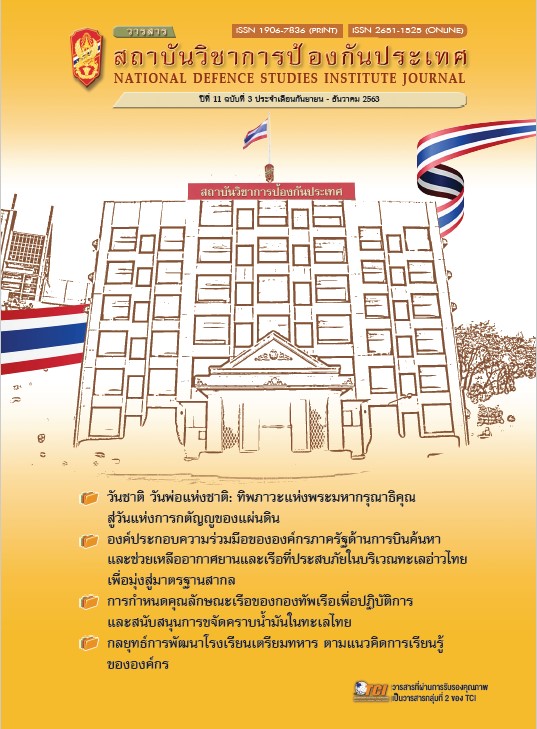The Appropriate Characteristic of the Royal Thai Navy Ship for Operate and Support Combating Oil Spills at Thai sea
Main Article Content
Abstract
This research aims to study desirable characteristics of surface ships for taking the roles as the unit of operation and support combating oil spills in the sea. As a result, the Royal Thai Navy will be equipped with proper tools for mission operation in accordance with the prevention and eradication of water pollution with regard to oil spill and the national plan for maritime security. In this regard, logic of force planning, as part of the strategy and force planning framework theory, is applied as a research guideline. The globalization theory is also used for explaining the origin of strategy. This research is a qualitative research based on documents, relevant environmental states, and technology. The data is collected by questionnaires from the samples, obtained by purposive sampling, and in-depth interviews with experts from national maritime security agencies, scholars who have studied impacts of oil spills, and guru of ship characterization.
The results reveal that globalization trends have caused higher worldwide demand for oil, along with non-traditional threats the also include marine environmental problems caused by oil spills. There are still frequent opportunities for oil spills in Thailand. Unfortunately, the Royal Thai Navy, as the unit in charge of operation and support combating oil spills in the sea, is ready to handle the situation at a certain level only due to a small number of tools and ships that fail to cover risky areas for oil spills in the sea. Nonetheless, initial preparations can be conducted by improving certain types of the Royal Thai Navy ships in order to enhance capabilities of combating oil spills. For long-term preparation, new surface ships must be procured, with the key characteristics in terms of worthiness, multipurpose use, necessary capabilities, and multiple-operation support. However, the characteristics of surface ships obtained are still just the concepts the have not been delved into technical details yet.
Article Details
The articles, images, tables, graphs, written content, and opinions published in this journal are solely those of the authors and do not necessarily reflect the views or positions of the National Defence Studies Institute or its academic affiliates.
References
กรมควบคุมมลพิษ. (2553). พื้นที่เสี่ยงต่อน้ำมันรั่วไหลในเขตทางทะเลของประเทศไทย. สืบค้นจาก http://www.mkh.in.th/index.php?option=com_content&view=article&id=277&Itemid=235&lang=th
กรมเจ้าท่า. (2562). สถิติน้ำมันรั่วไหล ระหว่างปี พ.ศ.2516-2560.
กองทัพเรือ, กรมยุทธการทหารเรือ. (2560). ยุทธศาสตร์กองทัพเรือ พ.ศ.2560-2579. กรุงเทพฯ: กองโรงพิมพ์ กรมสารบรรณทหารเรือ.
คณะกรรมการป้องกันและขจัดมลพิษทางน้ำเนื่องจากน้ำมัน. (2545). แผนป้องกันและขจัดมลพิษทางน้ำเนื่องจากน้ำมันแห่งชาติ. กรุงเทพฯ: กระทรวงคมนาคม.
บริษัท อิตัลไทย มารีน จำกัด. (2563). เรือป้องกันและขจัดคราบน้ำมันแบบอเนกประสงค์.
“พระราชบัญญัติการรักษาผลประโยชน์ของชาติทางทะเล” (2562, 12 มีนาคม). ราชกิจจานุเบกษา. เล่ม 136 ตอนที่ 30 ก.
“ยุทธศาสตร์ชาติ (พ.ศ.2561-2580)” (2561, 13 ตุลาคม). ราชกิจจานุเบกษา. เล่ม 135 ตอนที่ 82 ก. หน้า 1-71.
เย็นจิตร ถิ่นขาม. (2553). การพัฒนาและโลกาภิวัตน์: จุดจบของทรัพยากรธรรมชาติและสิ่งแวดล้อม. สืบค้นจากhttps://www.gotoknow.org/posts/358056
สิทธินันท์ มานิตกุล. (2557). การจัดตั้งองค์กรรักษาผลประโยชน์ของชาติทางทะเล (รายงานการศึกษาส่วนบุคคลหลักสูตรนักบริหารการทูต รุ่นที่ 6 ปี 2557). สืบค้นจาก http://www.mfa.go.th/dvifa/contents/filemanager/files/nbt/nbt6/IS/IS6027.pdf
สำนักงานสภาความมั่นคงแห่งชาติ. (2558). นโยบายความมั่นคงแห่งชาติ (พ.ศ.2558-2564). กรุงเทพฯ: (ม.ป.พ.).
สำนักงานสภาความมั่นคงแห่งชาติ. (2558). แผนความมั่นคงแห่งชาติทางทะเล (พ.ศ.2558-2564). กรุงเทพฯ: (ม.ป.พ.).
เอก ตั้งทรัพย์วัฒนา. (2554). โลกาภิวัตน์ บรรษัทข้ามชาติ บรรษัทภิบาล และความรับผิดชอบต่อสังคมของบรรษัท (พิมพ์ครั้งที่ 2). กรุงเทพฯ: สำนักพิมพ์แห่งจุฬาลงกรณ์มหาวิทยาลัย.
Fingas M., (2010). Oil Spill Science and Technology. Kidlington. U.K.: Gulf Professional.
Fingas M., and Brown, C. E. (2018). A Review of Oil Spill Remote Sensing. Sensors, 18(Special), 91-108.
Liotta P. H., and Lloyd, R. M. (2005). From Here to There-The Strategy and Force Planning Framework. In Naval War College Review, 58, 120-137.
Owens, M. T. (2007). Strategy and the Strategic Way of Thinking. In Naval War College Review, 60,111-124.


